
Container of olive oil (Lemone via Wikimedia Commons)
Diet Rich in Olive Oil Can Help Keep Heart Healthy
To keep heart healthy doctors recommend that you keep an eye on your cholesterol levels.
But there are two main types of cholesterol – LDL or bad cholesterol and HDL, also known as good cholesterol.
LDL cholesterol is bad because it builds up on artery walls which leads to heart disease, heart attack and stroke.
HDL cholesterol instead is considered good because it helps remove LDL cholesterol from the arteries.
So having low LDL levels, but high levels of HDL cholesterol can help keep your heart healthy.
A new study from the American Heart Association suggests that eating a Mediterranean diet enhanced with about 60 milliliters of virgin olive oil every day actually boosts levels of the good HDL cholesterol.
A Mediterranean diet is one that features vegetables, fruits, whole grains, legumes, and fish but is low in carbohydrates and meat, especially red meat.
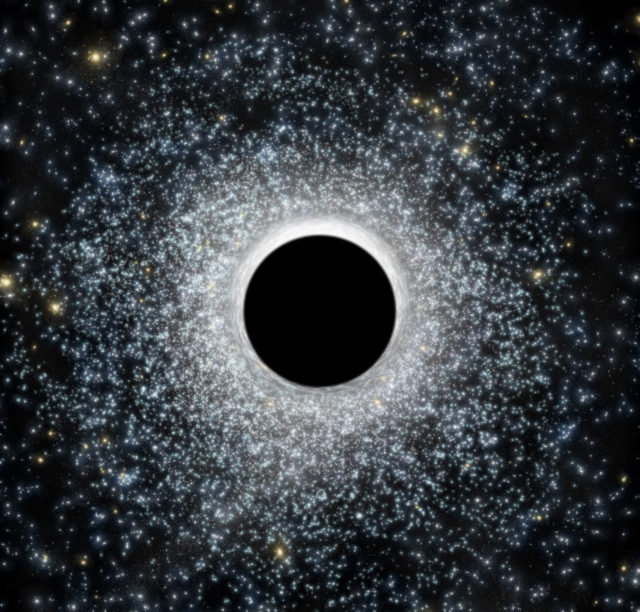
In this artist’s illustration, an intermediate-mass black hole in the foreground distorts light from the globular star cluster in the background. (CfA / M. Weis)
Elusive Medium Mass Black Hole Spotted
Astronomers have long thought that there are two types of black holes.
Smaller sized black holes called Stellar-mass black holes and gigantic supermassive black holes.
Astronomers at the Harvard-Smithsonian Center for Astrophysics say they found new evidence of a medium sized or intermediate-mass black hole, with a mass of 2,200 suns, hiding at the center of the globular star cluster 47 Tucanae (the toucan), some 13,000 light years from Earth.
A few intermediate-mass black holes had been spotted in the past. “All the previous claims of finding an intermediate black hole have been inconclusive, and subject to opposition by scientist who have shown the presented findings were equally consistent with other phenomena,” says Bülent Kızıltan, a Harvard astrophysicist in an email to Science World.
Kızıltan says scientists want to find intermediate-mass black holes because they are the missing link between stellar-mass and supermassive black holes.
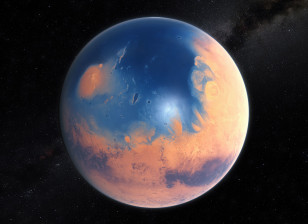
An artist’s impression shows how Mars may have looked about four billion years ago. (ESO/M. Kornmesser/N. Risinger/skysurvey.org)
How Could Ancient Mars Have Liquid Water?
Past observations made by Mars probes have suggested that the planet once had an abundance of water flowing over its surface.
But scientists have been left scratching their heads wondering how this would be possible considering the ancient sun was about 1/3 as warm as today.
A popular theory proposes that the Martian atmosphere was rich in carbon dioxide, which created a greenhouse effect that would have warmed the surface enough to allow liquid water to flow on the Red Planet.
But many say this couldn’t be possible since other studies suggest that about 4 billion years ago, Mars had lost its atmosphere to solar wind.
And recent findings by the Curiosity Mars Rover show that sedimentary bedrock from an ancient lake does not contain any carbonates.
NASA researchers say this lack of carbonates suggests that the Martian atmosphere could not have held carbon dioxide when water was said to flow on Mars some 3.5 billion years ago.
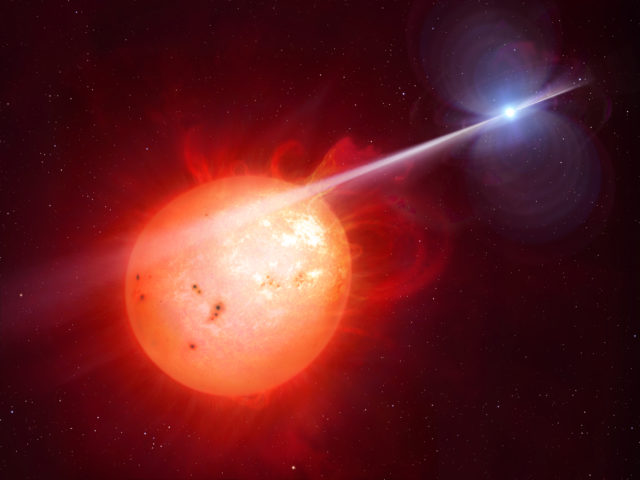
Artist’s impression of AR Scorpii. In this unique double star a rapidly spinning white dwarf star (right) powers electrons up to almost the speed of light. (M. Garlick/University of Warwick, ESA/Hubble)
Astronomical Oddity Discovered
Astronomers have discovered what is thought to be the first white dwarf pulsar to be found in the universe.
This astronomical oddity is located in a binary or two-star system, identified as AR Scorpii, some 380 light years from Earth.
White dwarfs are the remaining cores of medium mass stars that have used up their nuclear fuel.
Pulsars, known as the lighthouses of the universe because they emit powerful and bright pulsating beams of radiation, are usually associated with rotating neutron stars, remainders of massive stars that exploded in supernovae.
The white dwarf pulsar was found to be blasting its companion star, a red dwarf, with focused powerful beams of electrical particles and radiation.
And that is what, the astronomers say, causes the AR Scorpii system to brighten and dim twice every two minutes.
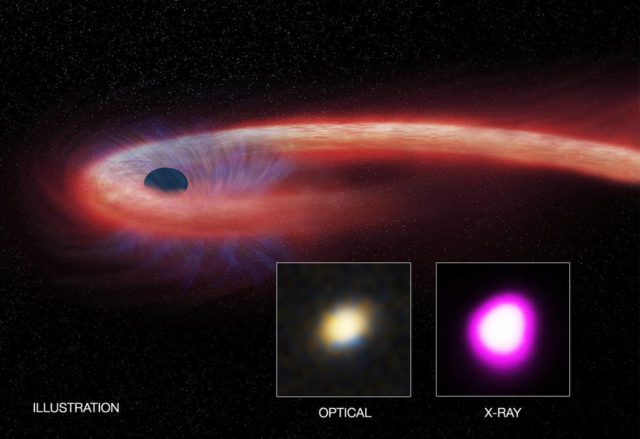
Artist’s illustration depicts what astronomers call a “tidal disruption event,” or TDE.
(Illustration: CXC/M. Weiss; X-ray: NASA/CXC/UNH/D. Lin et al, Optical: CFHT)
Black Hole Took Decade to Devour Star
Astronomers find that a supermassive black hole took about a decade to feast on the remains of a star it had ripped apart.
This astronomical incident, called a tidal disruption event or TDE, takes place when a star or other object wanders too close to a black hole’s event horizon, the point where its gravitational pull becomes so intense that nothing, even light, can escape it.
The astronomers say the TDE they discovered lasted more than ten times as long than any other observation of a star’s death by black hole.
The astronomical team thinks the star consumed by the giant black hole had to be either the most massive star to be ripped to shreds by a TDE or was the first observation of the most complete obliteration of a smaller star.
To make their findings the researchers used a trio of x-ray space telescopes – NASA’s Chandra and Swift and the European Space Agency’s XMM-Newton observatories.


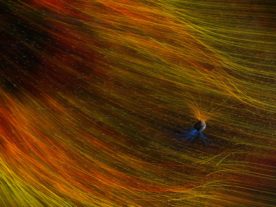





















Can I found any other information about this subject in different languages?